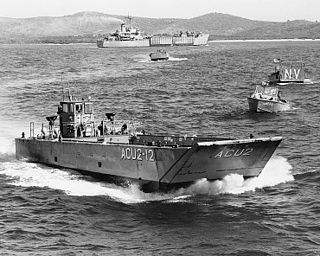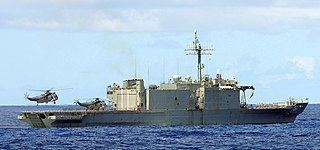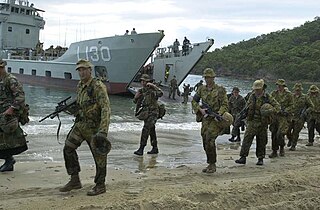
HMAS Choules (L100) is a Bay-class landing ship that served with the Royal Fleet Auxiliary (RFA) from 2006 to 2011, before being purchased by the Royal Australian Navy (RAN). The vessel was built as RFA Largs Bay by Swan Hunter in Wallsend, Tyne and Wear. She was named after Largs Bay in Ayrshire, Scotland, and entered service in November 2006. During her career with the RFA, Largs Bay served as the British ship assigned to patrol the Falkland Islands in 2008, and delivered relief supplies following the 2010 Haiti earthquake.

The LCM-8 is a river boat and mechanized landing craft used by the United States Navy and Army during the Vietnam War and subsequent operations. They are currently used by governments and private organizations throughout the world. The acronym stands for "Landing Craft Mechanized, Mark 8".

HMAS Kanimbla was a Kanimbla-class landing platform amphibious ship operated by the Royal Australian Navy (RAN). Originally built for the United States Navy (USN) as the Newport-class tank landing shipUSS Saginaw (LST-1188), the ship was decommissioned in 1994 and sold to the RAN.

The Balikpapan class is a ship class of eight heavy landing craft. All eight were originally laid down by Walkers Limited for the Australian Army in the early 1970s. A reorganisation of watercraft responsibilities in the Australian military meant the landing craft were to be operated by the Royal Australian Navy (RAN), with seven commissioned directly into RAN service during 1973 and 1974, and lead ship Balikpapan transferred from the army to the navy. During the leadup to the independence of Papua New Guinea in 1975, two of the vessels were transferred to the new Papua New Guinea Defence Force (PNGDF).

HMAS Manoora was a Kanimbla-class landing platform amphibious ship operated by the Royal Australian Navy (RAN). Originally built for the United States Navy (USN) as the Newport-class tank landing shipUSS Fairfax County (LST-1193), the ship was decommissioned in 1994 and sold to the RAN.
A joint support ship (JSS) is a multi-role naval vessel capable of launching and supporting joint amphibious and airlift operations. It can also provide command and control, sealift and seabasing, underway replenishment, disaster relief and logistics capabilities for combined land and sea operations.
The Royal Australian Navy, although a significant force in the Asia-Pacific region, is nonetheless classed as a medium-sized navy. Its fleet is based around two main types of surface combatant, with limited global deployment and air power capability. However, in 2009, a white paper, Defending Australia in the Asia Pacific Century: Force 2030, was produced by the Australian government which set out a programme of defence spending that will see significant improvements to the RAN's fleet and capabilities.

The Kanimbla class was a class of amphibious transport ships operated by the Royal Australian Navy (RAN). Two ships were purchased by Australia in 1994 and modified. Problems during the handover process and the need to repair previously unidentified defects meant the ships did not enter operational service until the end of the decade.

USS Saginaw (LST-1188) was the tenth of the Newport-class tank landing ships of the United States Navy which replaced the traditional bow door-design tank landing ships (LSTs). The second ship of that name, Saginaw was named after the river in Michigan. The LST was constructed by National Steel and Shipbuilding Company of San Diego, California, launched in 1970 and commissioned in 1971. During service with the United States Navy, the ship took part in US efforts in the Lebanese civil war and the Gulf War. Saginaw was decommissioned on 28 June 1994 and was transferred to the Royal Australian Navy on 28 August that year.

The Canberra class is a ship class of two landing helicopter dock (LHD) ships built for the Royal Australian Navy (RAN). Planning to upgrade the navy's amphibious fleet began in 2000, based on Australian experiences leading the International Force for East Timor peacekeeping operation. With a new climate for growing Australian Navy spending, a desire existed for forward defence capability for landing and supporting troops on Asian territory, that had never existed in Australian history, even with the old Majestic-class light fleet carriers, HMAS Melbourne and HMAS Sydney in the 1970s. In 2004, French company Direction des Constructions Navales (DCN) and Spanish company Navantia were invited to tender proposals, with DCN offering the Mistral-class amphibious assault ship and Navantia proposing the "Buque de Proyección Estratégica" design. The Spanish design was selected in 2007, with Navantia responsible for construction of the ships from the keel to the flight deck, and BAE Systems Australia handling the fabrication of the combat and communications systems. Finally, Siemens (Germany) supplied and fitted the azimuth thrusters.

A landing ship, infantry (LSI) or infantry landing ship was one of a number of types of British Commonwealth vessels used to transport landing craft and troops engaged in amphibious warfare during the Second World War. LSIs were operated by the Royal Navy, British Merchant Navy, Royal Canadian Navy, Royal Indian Navy, and Royal Australian Navy. They transported British Commonwealth and other Allied troops in sea assaults and invasions throughout the war.

HMAS Tobruk was a Landing Ship Heavy (LSH) of the Royal Australian Navy (RAN), based on the design of the Round Table-class of the British Royal Fleet Auxiliary. Planning for the ship began in the 1970s to provide the Australian Army with a permanent sealift capability. She was laid down by Carrington Slipways in 1979, launched in 1980, and commissioned in 1981. She was a multi-purpose, roll-on/roll-off heavy lift ship capable of transporting soldiers, APCs, and tanks, and delivering them to shore via landing craft or directly by beaching.

The Royal Australian Corps of Transport (RACT) is an administrative corps within the Australian Army. The RACT is ranked tenth in seniority of the corps of the Australian Army, and is the most senior logistics corps. It was formed on 1 June 1973 as an amalgamation of the Royal Australian Army Service Corps (RAASC) and Royal Australian Engineers Transportation Service. The RACT is responsible for the operation of army surface transport assets, movement control, terminal and postal services, and Army aspects of air logistic support.

The Royal Australian Navy and Australian Army have operated 29 amphibious warfare ships. These ships have been used to transport Army units and supplies during exercises and operational deployments.
Operation Yasi Assist was a multi-Service activity by the Australian Defence Force (ADF) as part of the response to Severe Tropical Cyclone Yasi. Coordinated to aid civilian emergency response efforts, at Federal inter-departmental level it was managed by Emergency Management Queensland. It comprised units and personnel from the Royal Australian Navy (RAN), Australian Army, and Royal Australian Air Force (RAAF) operating as Joint Task Force 664. The operation was initially commanded by Brigadier Stuart Smith, based at Lavarack Barracks in Townsville.

The LCM-1E is a class of amphibious mechanized landing craft manufactured by Navantia at their factory in San Fernando. These craft are intended to deliver troops and equipment onshore from amphibious assault ships during amphibious assaults. The craft are operated by the Spanish Navy and the Royal Australian Navy, and have been ordered by the Turkish Navy.

Forgacs Marine and Defence (Forgacs), former Forgacs Group, is a major Australian engineering and shipbuilding company. It has facilities at Newcastle, Sydney, Brisbane and Gladstone. The company employs 1000 people.
San Diego Marine was a shipbuilding company in San Diego, California. To support the World War 2 demand for ships San Diego Marine built: minesweepers and sub chasers. San Diego Marine was opened in 1915 as San Diego Marine Construction shipyard Captain Oakley J. Hall. The company was sold to Campbell Industries in 1972. It was sold again in 1979 and renamed Southwest Marine. Boatbuilding ended in 1983. Southwest Marine was sold to U.S. Marine Repair in 2003. The named changed to BAE Systems Ship Repair in 2005. The shipyard is located at 2205 East Belt Street, San Diego.














